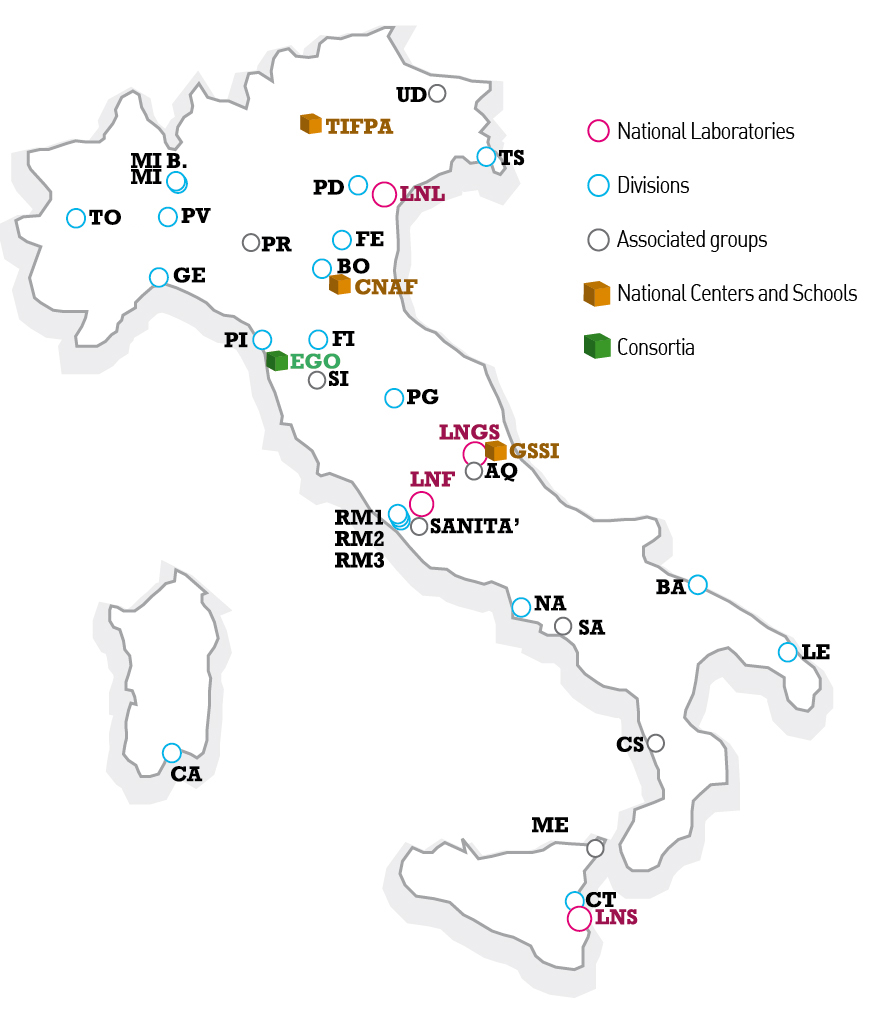JOB OPPORTUNITY
QUAGRAP
The interface of gravity and quantum mechanics
Scientific activities of the various Research Units
Albeit sharing common objectives the three knots of the network (Cagliari, Napoli and Trieste) have over time diversified their lines of research, which in this sense can be taken as complementary.
Cagliari Unit: This unit is based in Cagliari University (with the participation of Prof. Di Salvo from Palermo University). The members are experts in gravitational theories and in astrophysics. The planned research will concern noncommutative quantum field theory, with special attention to possible experimentally verifiable implications, like breaking of discrete symmetries or DSR-related effects. Another topic of research will be the possibility that long-range quantum gravity effects could play a role at galactic scales and could be responsible for effects usually ascribed to dark matter. Finally, we plan to investigate the possible signatures of the near-horizon geometry of black holes and other quantum gravity effects deducible from the observation of the properties of gravitational waves generated by the merging of black holes. The presence of astrophysicists in the group warrants a specific attention to the observational side.
Napoli Unit: This unit is based at Federico II University of Naples. The main lines of research planned for the near future are both on the more formal/mathematical aspects of the QG problem and in quantum-gravity phenomenology. On the formal side, we plan to focus on reaching a deeper understanding of the noncommutative spacetimes which are potentially relevant for the quantum-gravity problem, including the Snyder spacetime and the kappa-Minkowski spacetime. A large international effort over the last decade (with key contributions by members of our group) has allowed a solid understanding of classical field theories in these spacetimes, but several hurdles must be faced in order to reach the much-needed formulation of the associated quantum field theories. On the phenomenology side, we shall focus mainly on the opportunities which are expected to arise through the use of novel multisatellite telescopes and by the advent of multimessenger astronomy. Amelino-Camelia leads one of the working groups of the HERMES collaboration which is planning to deploy such a multi-satellite telescope, particularly suited for searching for traces of quantum spacetime-induced anomalous propagation of photons coming from distant gamma-ray sources. Moreover, the Napoli unit is involved in similar searches involving astrophysical neutrinos produced in gamma-ray bursts.
Trieste Unit: this is based in SISSA (with the participation of Prof. R. Balbinot from University of Bologna) and has a long-standing tradition in gravitation theory. The main lines of research planned for the near future are both on the theoretical side as well as on the experimental one. On the theoretical side the TS group will focus on the development and extension of theoretical frameworks, from DSR, SME, non-local/non-commutative effective field theory (EFT) and modified dispersion relations, to quantum-gravity-induced black hole mimickers and Finsler geometries, aiming at describing possible scenarios for low energy (sub-Planckian) effects induced by quantum gravity theories. In doing so it will also further exploit Analogue Models of gravity as toy models of emergent spacetime. On the experimental side we plan to have a close interaction with observational multi-messenger astrophysics (in particular for possible signature of deviations from standard black hole physics in gravitational wave events) and experiments in quantum optics and atomic physics aimed at testing several quantum aspects of gravitation.
QUAGRAP
The interface of gravity and quantum mechanics
Abstract
-
The search for a quantum gravity theory has been for a long time the subject of intense research. While we have nowadays several competing frameworks, none of them can yet claim to be a complete, fully predictive, theory. Even worse, the lack of experimental guidance has so far limited our options for selecting one proposal over the others. Quantum gravity phenomenology is an operational framework based on the realization that new physical phenomena, associated to some quantum gravity scenarios, can be amenable to observational/experimental tests even without directly accessing the Planck scale. The study of such theoretical possibilities, and of their phenomenological implications, is a typically interdisciplinary activity requiring the exchange of ideas between theoretical, experimental and observational communities. This research project aims at being a catalyst for research in quantum gravity phenomenology at the national and international level, by aggregating the core of Italian researchers in this field and at the same time be pivotal in creating an interdisciplinary network of collaborations within INFN and outside of it. The research activity is aimed at developing theoretical frameworks, including quantum spacetime models entailing departures from Lorentz symmetries and analogue gravity models, as well as exploiting at its best the wealth of data (available and expected) from multi-messenger astrophysics observations and high precision experiments.
QUAGRAP
The interface of gravity and quantum mechanics
INFN Unit Cagliari
Staff members
Prof. Salvatore Mignemi (PO, UniCagliari, 100%)
Prof. Mariano Cadoni (PO, UniCagliari, 60%)
Prof. Luciano Burderi (PA, UniCagliari, 90%)
Prof. Tiziana Di Salvo (PO, UniPalermo, 100%)
Dr. Andrea Sanna (RTDb, UniCagliari, 100%)
Other participants (Post-docs, Ph.D students,...)
Dr. Piero Olla (Ricercatore CNR 50%)
Mauro Oi, PhD student 3rd year (100%)
Zakaria Belkhadia, PhD student 3rd year (100%)
INFN Unit Napoli
Staff members
Prof. Giovanni Amelino-Camelia (PO, 100%)
Dr. Michele Arzano (RTDB, Uni. Napoli, 100%)
Dr. Giulia Gubitosi (RTDA, Uni. Napoli, 100%)
Other participants (Post-docs, Ph.D students,...)
Vittorio D’Esposito, PhD student 3rd year (100%)
Pietro Pellecchia, PhD student 1st year (100%)
INFN Unit Trieste
Staff members
Prof. Stefano Liberati (PO, SISSA, 100%)
Prof. Roberto Balbinot (PA, Uni. Bologna. 100%)
Prof. Marco Bruni (PA University of Portsmouth, 50%)
Other participants (Post-docs, Ph.D students,...)
Dr.Marc Schneider,postdoc
Vania Vellucci, PhD student 3rd year (100%)
Francesco Del Porro, PhD student 3rd year (100%)
Giulio Neri, PhD student 2nd year (100%)

